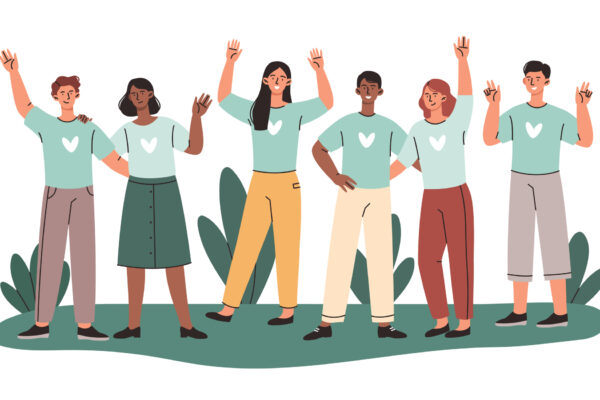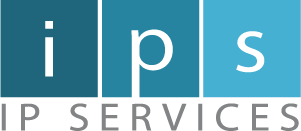Almost everyone agrees: the hybrid work model is here to stay. Not fully back to the office but no longer fully remote, many businesses are having to rethink what work and company culture mean in a hybrid model. For larger companies with multiple locations, this may be an easy transition, but for small or mid-size businesses (SMBs), more planning may be required.
At IP Services, we’ve been experimenting with a hybrid work model for more than a year and are carrying our successful approaches forward into 2024. A hybrid work model can be successful, as long as your business is able to continue to fully support your employees as they work both remotely and from the office. At IP Services, one approach we’re taking is a continuation of IPS Connects – the employee-led charitable giving and volunteer program we’ve been running for more than five years.

An Evolving Approach to Charitable Giving
Before the COVID-19 pandemic, we had several years of “normal” charitable giving events: in-office donation drives, in-person volunteer events, in-person rewards for hitting team or company donation goals.
We had a donation drive for new socks for the homeless community, and we collected them in our main production room so everyone could watch as a small pile of socks turned into a ridiculously large sock-mountain. We had in-person raffles at our summer picnic, with proceeds going to charitable giving events later in the year. We brought in a masseuse to give chair massages as a reward for the winning team of a charitable giving contest. We used a blackboard to track charitable giving amounts against our company goal for many events.
Then the pandemic happened, and we were – with almost no warning – all working from home. We had to regroup and learn new ways to continue our charitable giving.
We moved to a digital model, where all events happened online through Teams or email threads. Instead of collecting items to donate, we mostly donated money to nonprofits through their websites. We still had rewards for hitting our donation goals, but those were virtual, too – like the virtual chair yoga session we did on Zoom with a local yoga instructor. We relied heavily on email for communication, though admittedly, email flyers don’t always hit the same way as a physical in-office poster that everyone walks past several times a day.
Now we’re officially in a hybrid work model, and that comes with its own challenges. In-office schedules vary by team, which means we can never count on everyone to be in the office at the same time. Some folks are still working from home exclusively. Others work from the office every day. Many folks are working from the office and from home on different days. With this kind of variety in scheduling, it can be a challenge to make any type of morale program work. To help you out as you start planning your 2024 charitable giving program, below are five tips based on our own experience.

Choose Accessible Causes
When you have employees working all in the same area, it makes sense for your charitable giving events to benefit local charities and nonprofit organizations. But this approach may not work in a hybrid model; your staff may not all be located in the same region, especially if some employees were hired for fully remote positions during the pandemic. This diaspora may be nothing new to larger businesses that have multiple locations across the country or even globally, but it can be a stark change for SMBs that previously worked out of one or a few locations in the same region.
And yet, for SMBs whose staff is mostly in the same location (and mostly coming into the office at least semi-regularly), there can still be some draw for supporting local nonprofits. There’s no reason not to take advantage of that, just because fully remote staff or staff in other locations may not be interested in those particular causes. Causes need to be accessible, but they won’t all be accessible to the same group of people.
Our best advice for choosing causes is to choose a variety. If your staff is pretty evenly split between fully remote and in-office (at least part of the time), you may want to split your causes between local and remote. But if most of your staff is local and just a few are fully remote, it may make more sense to focus mostly on local causes, while still giving remote staff the opportunity to give to either national or local-to-them charities.
For example, in our 2023 food drive, most of the donations went to the food bank local to Erie (where the IP Services office is). But we recognized that remote staff may prefer to give to their own local food banks – so we gave them the option to donate there instead, with donations still counting toward our company goal and their contest team’s goal. We were able to generate more interest in this way than if we’d chosen a single food bank to support.

Choose Accessible Prizes
Prizes are a great way to provide incentive for participation in charitable giving or volunteer events. People like to give to good causes, but they also like to get something back. Before the pandemic, many of our prizes happened in-person – think happy hours, wine and paint nights, catered lunches at the office, or free swag that we handed out during business hours. During the pandemic, we moved to digital prize options – digital gift cards, virtual events (like the yoga class mentioned above), or physical items that we shipped to people (though the shipping costs can add up quickly).
When thinking of prizes for your hybrid staff, think variety. Not every prize has to appeal to every person, but having a digital and an in-person prize option for an event means everyone will have at least a chance of being interested, regardless of their work location.
For example, during our 2023 food drive, our incentives included both gift card options (some for local businesses, other for national chains) and a hoodie with the company logo. All prize options were open to anyone (remote or local), so we were able to generate a significant amount of interest in them – and in the cause by extension.
On the other hand, you don’t need multiple prize options for every single event. For one event in 2023 (a donation drive for a local nonprofit), we only offered one prize; everyone who donated was entered into a drawing for tickets to see our local Minor League Baseball team play (sports tickets were a staple prize before the pandemic).
Because the organization we chose to support in that event was a small local nonprofit, we knew not many remote staff would donate so the incentive could be something that would mainly appeal to local staff. And that’s okay – as mentioned above, not every prize needs to be accessible to everyone. Just be sure that enough prizes are accessible throughout the year to keep your remote and local staff all interested in your program.

Choose Accessible Volunteer Events
Volunteering is a great way to give back to the community without spending any money, but it’s an option that was mostly unavailable to us during the pandemic. We could of course encourage solo volunteering, but group volunteer events were avoided due to Covid concerns. We were finally able to get back to volunteering in 2023 (and had great success, which you can read more about here and here).
But of course, while local volunteer events are great for local employees (and can encourage interaction between folks whose in-office schedules don’t normally overlap), getting remote staff involved can be a bit more difficult. Our advice for this situation is to plan local volunteer events as normal, and then get your remote employees involved in deciding how and where they’d prefer to volunteer.
You can time your local and remote events for the same week or month, and when you talk about them afterward, be sure to acknowledge all the events that happened. It’s important for both local and remote staff to receive recognition for their hard work.
Most remote volunteer events will be solo activities, but you may also have a situation where more than one remote employee is located in the same region. In that case, encourage those employees to volunteer together, or coordinate a volunteer opportunity for them. This is the approach we’re planning to take in 2024 in light of our recent international expansion to Dublin.
One more thing to remember is that, even in the hybrid age, virtual volunteer opportunities are still available for you and your business. The best part of virtual is that everyone can volunteer, regardless of their location.
Get the Information Out There
Effective communication is so important when dealing with any aspect of the hybrid work model. In-office announcements and physical notices were a frequent go-to before the pandemic, then when everyone was remote, email and Teams chats were the only thing that would work. But now more than ever, there’s not one single best way to communicate with everyone in the company.
As with the other tips mentioned above, the buzzwords here are accessibility and variety. You’ll need to communicate in a variety of ways to catch everyone’s attention regardless of their work schedule – and some specific situations will lend themselves more toward one communication method than others.
There’s a lot to communicate when you’re putting on a charitable giving or volunteer event. People need to know the date(s) of the event, the charity that benefits from the event, if there’s a contest aspect, details about any prizes or incentives, and any goals that your company has set.
And the way in which you say all of that matters – it has to be eye-catching and engaging to get attention. To catch the eye of the in-office staff, posters or flyers may do the trick. Emails and messenger communication are your best bet for remote staff. For updates on any events (ongoing donation totals, for example), email is the way to go; that way the entire company can access the information at the same time. The same goes for sign-up sheets; digital sign-ups can make life a lot easier than trying to juggle multiple paper lists.
Another thing it will be important to communicate – and frequently – is if your company has a charitable matching program. Studies show that matching programs can be a huge incentive for employees, but not many employees (only 10%) take advantage of them… likely because most employees don’t know or remember that it’s an option. While you’re upping your communication game to better engage your hybrid staff, you should take the opportunity to talk about your matching program. And if you don’t have one – it’s worth looking into!

Meet Your Team Where They’re At
Studies show that a good charitable giving program can improve morale and reduce turnover – but it has to be executed thoughtfully. It may be tempting to squeeze in as many events as possible to maximize the benefit, but that could backfire bigtime. You don’t want to ask more of your employees than they have to give, whether it be money or time. Your staff has financial and time constraints that you need to be mindful of. Space out your charitable giving and volunteer events to give your staff time to recover from one event before diving into another.
Debrief on each event after it’s over and ask yourself if participating in it was beneficial to your staff, as well as to the organization you donated to or volunteered with. Was it fun? Was it meaningful? Did you give company-wide recognition to those who participated? You could consider surveying your staff quarterly or annually to ask questions like these. This is a program for your employees, so they should be getting some benefit from it.
Your expectations also need to be realistic. Because of the financial and time constraints we just referenced, you should never expect 100% participation rate. One notable study shows that the average participation rate for corporate volunteer events is 33%. Microsoft, which is notable for its company culture, reports that 65% of employees take part in their charitable giving program. High-interest events with good incentives and effective communication may generate higher participation than other events, but you should still be aware of these averages during the planning stage of any event.
If giving back to the community is as important to your business as it is to ours, a revitalized charitable giving program may be just what you need. By following these tips, you can make your charitable giving program a success in the world of hybrid work.

written by
Tonya Boyer
January 9, 2024
Stay informed with industry-relevant emails curated by our team of experts.
We send out emails once or twice a month relating to IP Services, industry news, and events we'll be attending so you can meet our experts in person.

Tonya Boyer
Tonya has been with IP Services since 2014. After several years serving as a Subject Matter Expert in the cloud computing space, she began managing the Fraud Protection team in 2017. She believes in creating a happy, casual but professional workspace where everyone can live their best lives while doing good work. She is dedicated to community outreach and helps coordinate the IPS Connects volunteer and donation committee.



